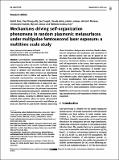Por favor, use este identificador para citar o enlazar a este item:
http://hdl.handle.net/10261/269294COMPARTIR / EXPORTAR:
 SHARE SHARE
 CORE
BASE CORE
BASE
|
|
| Visualizar otros formatos: MARC | Dublin Core | RDF | ORE | MODS | METS | DIDL | DATACITE | |

| Título: | Mechanisms driving self-organization phenomena in random plasmonic metasurfaces under multipulse femtosecond laser exposure: A multitime scale study |
Autor: | Eles, Balint; Rouquette, Paul; Siegel, Jan CSIC ORCID ; Amra, Claude; Lumeau, Julien; Moreau, Antonin; Hubert, Christophe; Zerrad, Myriam; Destouches, Nathalie | Palabras clave: | Nanocomposite materials Nanoparticle reshaping Nanoplasmonics Self-organization Thermal modeling Waveguide |
Fecha de publicación: | 18-mar-2022 | Editor: | Walter de Gruyter | Citación: | Nanophotonics (2022) | Resumen: | Laser-induced transformations of plasmonic metasurfaces pave the way for controlling their anisotropic optical response with a micrometric resolution over large surfaces. Understanding the transient state of matter is crucial to optimize laser processing and reach specific optical properties. This article proposes an experimental and numerical study to follow and explain the diverse irreversible transformations encountered by a random plasmonic metasurface submitted to multiple femtosecond laser pulses at a high repetition rate. A pump-probe spectroscopic imaging setup records pulse after pulse, and with a nanosecond time resolution, the polarized transmission spectra of the plasmonic metasurface, submitted to 50,000 ultrashort laser pulses at 75 kHz. The measurements reveal different regimes, occurring in different ranges of accumulated pulse numbers, where successive self-organized embedded periodic nanostructures with very different periods are observed by post-mortem electron microscopy characterizations. Analyses are carried out; thanks to laser-induced temperature rise simulations and calculations of the mode effective indices that can be guided in the structure. The overall study provides a detailed insight into successive mechanisms leading to shape transformation and self-organization in the system, their respective predominance as a function of the laser-induced temperature relative to the melting temperature of metallic nanoparticles and their kinetics. The article also demonstrates the dependence of the self-organized period on the guided-mode effective index, which approaches a resonance due to system transformation. Such anisotropic plasmonic metasurfaces have a great potential for security printing or data storage, and better understanding their formation opens the way to smart optimization of their properties. | Descripción: | 16 pags., 5 figs. | Versión del editor: | https://doi.org/10.1515/nanoph-2022-0023 | URI: | http://hdl.handle.net/10261/269294 | DOI: | 10.1515/nanoph-2022-0023 | E-ISSN: | 2192-8614 |
| Aparece en las colecciones: | (CFMAC-IO) Artículos |
Ficheros en este ítem:
| Fichero | Descripción | Tamaño | Formato | |
|---|---|---|---|---|
| Mechanisms driving self-organization.pdf | Artículo principal | 2,71 MB | Adobe PDF |  Visualizar/Abrir |
| suppl_j_nanoph-2022-0023_suppl.docx | Supplementary information | 8,42 MB | Microsoft Word XML | Visualizar/Abrir |
CORE Recommender
SCOPUSTM
Citations
5
checked on 19-abr-2024
WEB OF SCIENCETM
Citations
4
checked on 26-feb-2024
Page view(s)
36
checked on 28-abr-2024
Download(s)
45
checked on 28-abr-2024
Google ScholarTM
Check
Altmetric
Altmetric
Este item está licenciado bajo una Licencia Creative Commons

